Locative media first came onto my radar in 2005 when notice of a collective called Proboscis and their Urban Tapestries initiative hit my inbox at NMK. Excuse me, geotagging the city you say? My curiousity was duly piqued…
Looking into it, I discovered an intriguing creative underground of technologists and artists doing some rather facsinating things with urban geo-mapping, robotics, storytelling and locative media. They even released a limited edition downloadable book about their work.
This was definitely a fringe phenomenon but the Social Tapestries project followed, and along with PLAN (Pervasive and Locative Arts Network), a 2-day globally-framed conference on wireless locative media at the ICA I was lucky enough to attend, it was clear this was coming out of obscurity. Augmented reality was coming to a place near you and me…
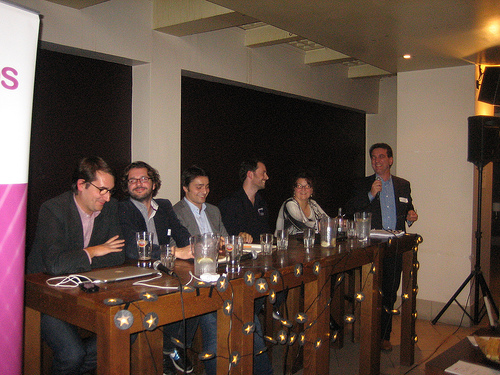
Courtesy of Chinwag Live: Search & LBS. L-R: Plazes, Taptu, The Cloud, Rummble, MSearchGroove, Jo Rabin
Jump forward three years, and while things haven’t exactly moved at light-speed, the calibre of people and companies we invited to speak at Chinwag Live: Search & Location Based Services on 8th October bespoke a phenomenon that is now unstoppable. Moreover, we’re now witnessing the birth of its business development phase…
PANEL:
Felix Petersen – Co-founder, Plazes / Head of Product Management, Social Activities, Nokia
Chris Moisan – Product & Market Development Manager, Taptu / blog
Andrew Scott – Co-founder, Rummble
Peggy-Anne Salz – Chief Analyst & Producer, MSearchGroove
Adrian Drury – Head of Commercial Strategy & Business Development, The Cloud
CHAIR: Jo Rabin – Consultant & Co-Founder of MoMo London
When an articulate line-up of some of the global leaders in mobile search and LBS are giving their best right in front of you, it can be hard to keep up. So I decided to change tack in my note-taking habits for our events series. I focused on listening to the panel discussion, and then took sporadic notes of points that struck me in the later discussion with the audience.
And boy, it was a conference-load of information packed into 100 minutes. But I needn’t have worried, because not only do we have the fantabulous podcast (coming next week), there have also been some superb write-ups from delegates including Mjelly, Cogapp and Mido.
Privacy’s endless permutations
Privacy and security are big issues stalking this space. If your location is being tracked – sure, that’s a technical achievement. But why would you want your friends to know you’re in a work meeting, or your employers to know your nocturnal movements, or your ex-partner to know you’re in a nearby restaurant with your new flame..? The permutations are endless.
Plazes CEO and product honcho of Social Activities at Nokia Felix Petersen stated that the privacy issue is threefold – firstly: tracking (passive / implicit) versus publishing (active / explicit). But there’s the mental transaction cost of changing your presence status all the time. The second aspect of privacy is time; for example, is it okay if people see me after 8pm? Also, the kind of place. There are complexities to sharing and personal relations in real life that need to be addressed, and as far as I’m concerned slicing them by “my friends only / family / everyone” barely scratches the surface.
The challenge is how to bake in these options without making it too complicated, Petersen reflected. That’s the third aspect – people want privacy options but they won’t use them much. In reality, Plazes have found 90% of the people don’t use it, but that doesn’t mean that it doesn’t need to be there, he stressed.
Andrew Scott of Rummble told a similar tale. They have these privacy settings and only about 5% of their users use them; on the other hand, 25% of photos (on Rummble or Flickr) are geotagged.
Who owneth the data, maketh the sale..?
Adrian Drury of The Cloud remarked that there’s an interesting question about who owns the data when lots of different players are coming into the value chain, for example Skyhook, and ad-serving platforms. How do we protect the user from their data being abused? The people that own the brand relationship aren’t usually the same people that own the geodata.
As talk turned to the topic of monetising LBS and mobile search, Andrew Scott said media buyers needed to be more flexible about the stock they buy, in order to make relevant advertising work. Adrian Drury brought it back to the inventory question and where the money is; he stressed it’s about scale, scale and scale.
At the point where the LBS industry can deliver enough volume of users, volume of available devices and consistent platforms, then we can actually go out to groups of people or industries that are marketing and advertising and have an interest in doing that on a location based basis, and who can actually build campaigns around stuff that is location-based; then suddenly you bring another element to this industry. Today there are X-thousand iPhones in the UK, in 24 months there will be a multiple of that. That’s another consistent platform, and offers advertisers the availability to push campaigns out to that platform.
Interactive billboards – poised to pounce?
Interestingly, Adrian cited the billboard industry as ones to watch – the JC Decaux and Viacom’s of this world. They are one enormous advertising inventory industry that is yet to converge with the digital world in any significant way. But obviously location-based services bring them immediately into the digital world, Adrian observed, and they will be – and are – thinking about that quite heavily.
If it’s pull it might work, Felix countered, but he reckoned its niche. What doesn’t scale is the example of a billboard pushing something to you. It’s either too small an audience (one person on holiday walking across a bridge in Istanbul) or it’s just super-spam.
Billboard advertising (via Bluetooth I assume) won’t work if it’s done in a spam like way, Felix continued. The alternative? Either you start profiling (very time consuming, not very attractive) or you have socially relevant check-in points, for example being checked into a relevant wifi network (in Starbucks, or a hotel or an airport) – that’s the closest model to what we have on the web right now. Banners don’t work, he elaborated, but ads that react to your interaction with a location are going to be received differently (like Adwords react to the content of the page you are on and the history of your searches), and that’s what we need to crack.
Recommendation and discovery – playing the long game?
In this vein, Peggy was far more excited by content recommendation and discovery. She mentioned ChangingWorlds – a server side solution that does the profile building and what Xtract has done with Blyk. Granted, it involves heavy-lifting and mega-crunching of data, but it’s a much more exciting opportunity and potentially *far* more lucrative.
Claudia Poepperl from Mobile People (mobile local search) noted that the Yellow Pages industry is $30billion industry, that’s where the money is. How much are the panel partnering with Yell or Yellow Pages in order to tap into that massive revenue stream? Andrew Scott said it’s too complicated for local advertisers – it’s the heavy lifting that stopping them getting it right, and Rummble simply won’t carry these ads until they are personalised and relevant.
Intermediary quandaries and scale
Chris Moisan of Taptu said, as a mobile search engine, if you know someone’s location and there’s an intention then having Yellow Pages content where there’s a relevancy is a no-brainer. But the issue for them as a start-up is that to index that much local content isn’t possible yet.
Felix observed that the key intermediary is who whoever bills and owns the namespace for the small retailer. As yet, there’s no unified scheme comparable to phone numbers that allow the small to medium sized local retailer to claim this space that someone else has built.
Qype and Yelp are trying, but they’re rather small, he explained. Whoever will own it can unify it. Yellow Pages are in a good position to do that but they don’t. At the moment it’s the preserve of Google and Nokia.
Scope for location based advertising?
Joel Brazil from Tipped asked how many local search services would you expect an average local retailer would buy advertising from annually; and how would they actually engage in the sales transactions? How many different sales reps could they entertain and buy advertising from?
Adrian replied probably not a lot. At the minute you have a brand relationship or a portal relationship – Yell, Google etc, and they will give most advantage. Felix simply said it’s whoever owns the namespace, whoever drives the traffic. Peggy Anne Salz of MSearchGroove explained that she was doing research for NearbyNow, looking at special offers and exclusives for location based advertising. One major benefit might be in stock replenishment.
Andrew Scott reiterated that companies need scale to make these marketing campaigns work; and the most relevant and least intrusive ads work best. In the future there will be mobile, geocoded ads, remarked Felix later in the debate.
Platform wars: telcos v operators v digital media decks
Adrian situated the fragmentation and user experience issues more broadly. The mobile network operators are old fashioned telcos, and do things very slowly. They have this GPS platform; they’re all able to do this and none of them have productised it particularly well at all.
They did a very bad job in their media deck and they had years and years lead-time to get it right! Then along comes Apple, puts a good media deck on their network and gets it right, with Nokia following close behind them. That will change things and there will be a real fight, Adrian predicted. Who owns the location data – is the operator or someone else? Whoever controls the location data will be the one who wins the war and takes the margin on this, he predicted.
Technically it’s been possible for over ten years for the operators to know where you are, by triangulation and other means, Felix concurred. But the operators just saw it as a way of retaining customers, which totally misjudged the nature of this kind of service which grows in value when you can use it with all your friends, not just your friends on the Vodafone network. That was their fatal mistake.
Power moves to the edge…
But new technologies have changed this, Felix said. Now the power really is moving to the edge: with GPS phones, with third-party providers like Skyhook who provide the wifi databases, and you now have the crunching power in the phone itself. The context is really here in the phone, not in the network – calendaring, who is close by, how many of your friends are in the room.
Like with Nokia Maps, he explained, you don’t need to build something into the *highways* to see if there’s a traffic jam, because if you have enough people using Nokia Maps you can see how fast they move and if they’re all slowing down, then there’s a traffic jam..
Andrew remarked that on a recent trip to the States, he discovered that AT&T were considering scrambling their user cell ID info so that Google couldn’t use it. But Rummble use Skyhook, Google Gears and Google Maps, so they’re not dependent on the operators. Adrian added that wifi networks are also distintermediating the operators. Yet more mounting evidence of the coming battle in this space…
Business in the here and now
Dan from Sponge wasn’t convinced the pot of gold is Yellow Pages. But, he asked, how can the fragmented world of location based services present something simple and attractive to the Slug & Lettuces and Heinekens of this world? Adrian replied there’s a massive difference between whether you’re doing search or display advertising.
With talk turning again to marketing budgets, Adrian encapsulated the barriers currently facing marketers in the location-based space – you need to give media campaign planners enough scale so that they can organise their budgets. In turn, he asked, what premium is there on location?
Such scale in location based services has not currently been achieved, the panel agreed, and clearly no one had all the answers. But I’ll wager some of the companies involved in this absorbing discussion will play a part in changing that.
Merging physical and digital space
While the business development side of LBS is getting interesting, it’s all a million miles from the work of Proboscis and their ilk. But Felix Petersen said that truly locative media will facilitate some amazing things; people will not change, but outcomes will. And this very week (until this Sunday Friday 24th October!) another quite remarkable London-based urban mapping and discovery project is underway.
This time locative authoring and the “public based commons” is getting an accessible game-play twist, with the individual (but collective) mapping out of the answer to a question that players must solve by getting involved in discovering hidden objects and mapping them by GPS.
Utilising Twitter, mobile blogging and GPS, it’s the work of Moblog co-founder Alfie Dennen (in association with Demos, HomeMadeDigital and TED), whose objective is to unlock the urban “noticer” in all of us within a fun, engaging scenario, whilst also raising awareness of the XDRTB campaign started by photographer James Nachtwey which is highlighting the ravages of drug-resistant tuberculosis. As it happens, Alfie is also speaking at our next evening panel ‘MoSo Rising’ on November 11th.
The occurrence of these two separate events in the same fortnight in London was not consciously pre-planned, I promise. But it’s certainly something to be noted, or should I say “noticed”. One thing’s for sure – Felix Petersen was dead right to say the merging of real-life and digital location is starting to move in from the edges. The clue is in the patterns emerging. Better watch out…
—-
[NB: Really, this is just a fraction of what was covered in this event. I especially recommend Mjelly’s post for coverage of the event’s first half. I’ll update this post next week with a link to the podcast when it’s released]
[NB 2: cross-posted on my Chinwag blog]
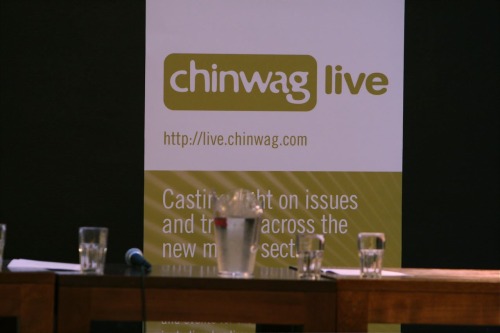

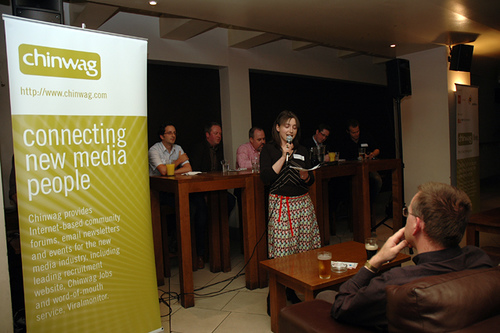
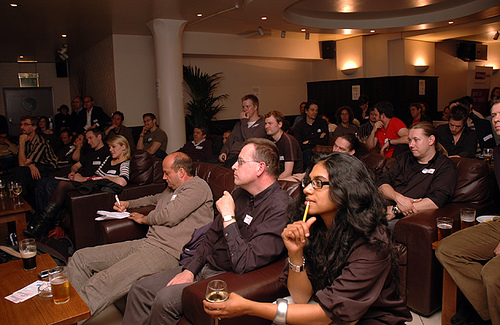
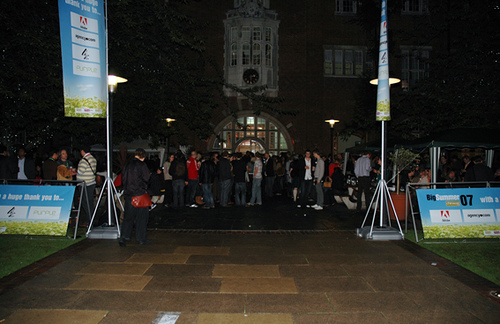


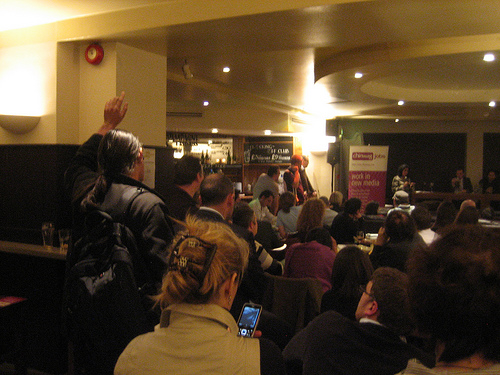

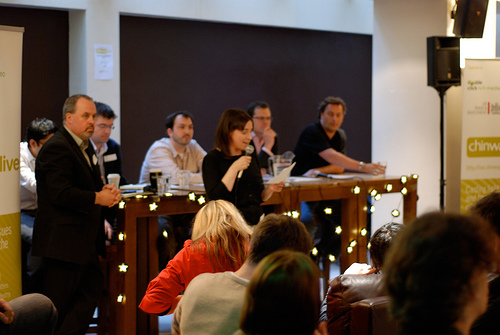
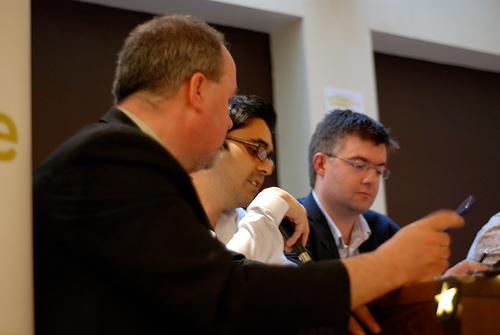
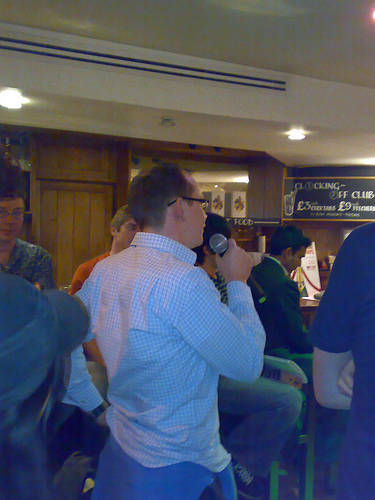


How we knit the webosphere together – lessons so far
This is outta character, but I’m reposting a comment I made on the Broadstuff (aka Broadsight’s Alan Patrick’s) blog within the last hour, with a few corrections…
Here’s the original post: Bitchin’ About Aggregator posts on Techmeme
To recap on Broadstuff’s key points:
Here’s my verbose response (but it’s a mammoth issue – my lame excuse)
(1) Initially, in terms of connecting blogosphere conversation together there was trackback, but then along came the traditional publishers and they couldn’t deal with the (spam / gaming) issues, nor incorporate the lessons of online communities’ design or etiquette so far. Thus the promise held out by trackback (see Nico Macdonald, ‘Comment is Free,’ but designing communities is hard, Online Journalism Review, 17th July 2006) was quashed.
(2) Then trackback spam arrived (your favourite Alan) – possibly the final nail in the coffin of trackback’s potential (if we agree pingbacks are the watered-down substitute).
(3) In turn, beyond mere feed readers, more sophisticated aggregators like Netvibes and other “thin portal[s] of widgets” (to quote Mike Butcher on a post about Sleevenotez he wrote on Vecosys, since deleted by the blog owner) entered the arena, along with cross-platform microblogging. The social web and mobile stuff more generally – rather than just the blogosphere – at least became more manageable [see also Jaiku, though it’s gone quiet since Google acquired it late in 2007, and interesting lifestream propositions like Rememble].
(4) But before we could take a breath, social networks went zoom, and we were pouring tons of valuable-to-trivial content, discussion and links (it’s all a continuum, right) into the likes of Facebook and Bebo. But it was hellish-difficult/impossible to connect this back out to the open internet, the ahead of its time [and much lamented] BlogFriends for pouring back in-and-out notwithstanding.
(5) Now we have the next wave of aggregators: Friendfeed, favorit, Plaxo’s Pulse feature, the recently souped-up MyBlogLog et al.
(6) And hot on their tails – for the blogerati – Cocomment, Disqus, SezWho, and IntenseDebate became part of the equation, some of whom even have social network integration in their pipeline apparently 🙂 [my, that sounds rather painful]
(7) This doesn’t even factor in the photo and video outfits out there – Seesmic, Qik, Flickr video, Google Video, Vimeo, BlipTV [gratuitous interview and Beers & Innovation RSS Frontiers video linkage], Moblog and the like; especially the cross-platform players among them. Who has even mentioned or interrogated their part in the connected web in this month’s discussion? Yep, time to remove the old-skool web goggles.
So now that the conversation has left the blogosphere [ReadWriteWeb, 20th March 2008] where does that leave us?
If the walled garden is crumbling, but our attention is ever more stretched, and our conversational quality and digital health suffering, is the model of aggregating eyeballs doomed or due for a fresh lease of life from the most innovative but implacably dominating mover in this space?
And / or in biz parlance, has the reverse aggregator got legs?
I’d love to hear what folks think about all or any of this. Then I can go back to knitting or eating chocolate to calm down – apparently that’s what works for people who aren’t bona fide geeks and are seen to be interrogating stuff above their station, or asking questions that are difficult. Who knew? Go experts! 😉
—————-
PS. All of which makes me even more convinced that the questions we asked in London (and the blogosphere – joint blog by Mike Butcher + Deirdre Molloy) in June 2006 at the NMK Content 2.0 conference, which I co-organised with NMK co-worker Nick Watt, still haven’t been seriously addressed.
PPS. So much for the networked age!
PPPS. Buce Sterling on why the interweb’s a mess 🙂
5 Comments
Posted in Innovation, Media, NMK, Social Software, Start Ups, Technology and Software
Tagged Aggregators, Blogging, comments, community, Convergence, conversation, Moblogging